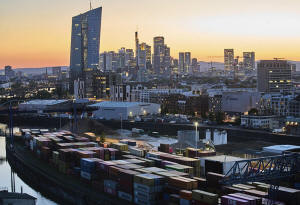Europe saw stronger growth at start of year, but Trump's tariffs have
darkened outlook
[April 30, 2025] By
DAVID McHUGH
FRANKFURT, Germany (AP) — Europe’s economy grew more strongly in the
first three months of the year, only to see hopes for an ongoing
recovery quickly squelched by U.S. President Donald Trump’s trade war.
Gross domestic product in the 20 eurozone countries grew 0.4% in the
first quarter, improving on 0.2% growth in the last part of 2024,
according to official figures released Wednesday by European Union
statistics agency Eurostat.
But on April 2, just two days after the end of the quarter, Trump
announced an onslaught of new tariffs on almost every U.S. trading
partner and hit goods imported from the EU with a 20% tariff rate. That
has led to widespread downgrading of Europe’s growth outlook for the
year since its economy is heavily dependent on exports and the U.S. is
its largest single export destination.
Although Trump has announced a 90-day pause on what he calls his
“reciprocal” tariffs — so named because they are based on how he feels
other countries have been treating the U.S. —prospects that the EU can
strike a bargain to reduce the 20% figure are highly uncertain.
Meanwhile, other tariffs — such as a 25% rate on steel and aluminum and
on cars, both of them for all trading partners, including Europe, remain
in place. The costs of tariffs are paid by the companies that import
European goods such as cars and pharmaceuticals, which then have to
decide whether to swallow the costs or pass them on to the consumer in
the form of higher prices.

As a result, indicators of business and consumer optimism in Europe have
fallen. The European Commission’s economic sentiment indicator sagged to
93.6 in March, its lowest level since December. That drop in sentiment
is “another illustration of how the last four weeks of tariff tensions
and uncertainty have entirely wiped out the tentative return of optimism
in the eurozone,” said Carsten Brzeski, global head of macro at ING
bank.
[to top of second column] |

Containers are piled up in a cargo terminal in Frankfurt, Germany,
Monday, April 28, 2025. (AP Photo/Michael Probst, File)
 “Unless there are major changes in
U.S. trade policy, sentiment as well as economic activity in the
eurozone will remain subdued over the coming months," Brzeski said.
Before Trump's announcement, hopeful signs had included a strong job
market, with unemployment low at 6.1% and consumers beginning to
spend more after several years of holding back because of inflation.
With inflation down to 2.2%, the European Central Bank has been
lowering the cost of credit for consumers and businesses by cutting
its benchmark interest rate seven times in its current easing cycle,
most recently by a quarter of a percentage point on April 17.
On top of that, the German parliament has approved a 500-billion
euro ($570 billion) investment fund that’s exempt from the country’s
constitutional limits on debt. That decision by the incoming
coalition of the center-right Union bloc and the Social Democrats
has raised hopes of additional spending on pro-growth infrastructure
over the coming years.
However, Trump’s tariffs have lowered expectations for Germany, the
eurozone’s largest economy and its economic problem child. The
outgoing government under Chancellor Olaf Scholz lowered its growth
estimate for this year to zero after two previous years of declining
output. Parliament is expected to elect center-right Union leader
Friedrich Merz as chancellor on May 6 in the wake of a Feb. 23
national election.
All contents © copyright 2025 Associated Press. All rights reserved |